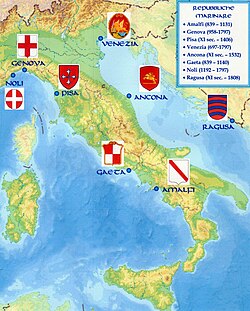Republic of Noli
Republic of Noli | |||||||||
|---|---|---|---|---|---|---|---|---|---|
| 1192–1797 | |||||||||
 Flag
 Coat of arms
| |||||||||
 Location of the Republic of Noli | |||||||||
 Location of Noli in Italy, depicted along with other maritime republics | |||||||||
| Capital | Noli | ||||||||
| Common languages | Ligurian, Latin, Italian | ||||||||
| Religion | Roman Catholic | ||||||||
| Government | Aristocratic oligarchic republic (City-state) | ||||||||
| Podestà as Head of state | |||||||||
| Historical era | Middle Age, Renaissance, Early Modern Age | ||||||||
• Established through decree by Henry VI, Holy Roman Emperor | 7 August 1192 | ||||||||
• Annexation by the Napoleonic Kingdom of Italy | 2 December 1797 | ||||||||
| Area | |||||||||
| 18th century | 4 km2 (1.5 sq mi) | ||||||||
| Population | |||||||||
• 18th century | 1,500[citation needed] | ||||||||
| |||||||||
| Today part of | Italy | ||||||||
The Republic of Noli (Italian: Repubblica di Noli; Ligurian: Repubbrica de Nöi) was an Italian Maritime republic centered on the city of Noli, in Liguria, that existed from 1192 to 1797. Present-day Noli is in the Italian province of Savona. To protect itself from possible attacks and invasions by Savona and Marquisate of Finale, Noli allied in 1202 with the Republic of Genoa in a sort of protectorate, in fact, documents of the time show that the relationship was equal and not one of submission.[1] Thanks to this alliance, the Republic's importance grew to such an extent that in 1239 a diocese was established there by Pope Gregory IX.
History[]
Noli was founded in 1192. It survived for 605 years, before being annexed by Napoleon in 1797.[2]
Economy[]
Despite its small size, Noli's good shipyard and harbor allowed them to become a commercial power.[3] They had good trade relations with Genoa, as they only had to pay one penny to be allowed to trade in Genoa, whereas the Spanish had to pay 60 pennies to be allowed to trade.[4]
Military[]
Noli's efficient shipyard allowed them to become somewhat of a naval power, despite their small size.[3] Their alliance with Genoa afforded them much protection, especially as Genoa used Noli's port to shelter their ships.[5]
It is known that during a conflict with Savona, Noli sacked the town of Spotorno, which was owned by them, in 1227.[6]
Foreign relations[]
In 1202 Noli was threatened by . In response to this Noli formed a confederation with the powerful Maritime Republic of Genoa.[5][2] Noli kept this alliance until they were dissolved in 1797.[3]
Flag[]
The flag of Noli was first created in the 13th century, with a white cross and a red background, the exact opposite of Genoa's flag. Many of the merchant ships of Noli chose to fly under the Genoese flag, as it commanded much more respect.[3]
Religion[]
In 1239 the Pope appointed a bishop to Noli.[7]
References[]
Citation[]
- ^ De Negri, Teofilo Ossian. Storia di Genova: Mediterraneo, Europa, Atlantico (in Italian). Aldo Martello Editore. p. 320.
- ^ Jump up to: a b Facaros & Pauls 2006, p. 112.
- ^ Jump up to: a b c d Flag Institute.
- ^ Epstein 2001, p. 39.
- ^ Jump up to: a b Finley 2001, p. 120.
- ^ Whitehouse 2016, p. 201.
- ^ Whitehouse 2016, p. 202.
Books[]
- Epstein, Steven A. (2001). Genoa & the Genoese, 958-1528. Chapel Hill: The University of North Carolina Press. ISBN 9780807849927.
- Facaros, Dana; Pauls, Michael (2006). Italian Riviera & Piemonte. London: Cadogan Guides. ISBN 9781860113086.
- Finley, Amy (2001). Adventure guide the Italian Riviera San Remo, Portofino, Genoa. Edison, New Jersey: Hunter Publishing, Inc. ISBN 9781588435774.
- Whitehouse, Rosie (2016). Liguria. Bradt Travel Guides. ISBN 9781784770105.
Websites[]
- Breschi, Roberto. "Small and Very Small States in Italy that Lasted Beyond 1700 - A Vexillological Survey" (PDF). Flaginstitute.org. Retrieved 24 March 2017.
- Maritime republics
- Italian history stubs